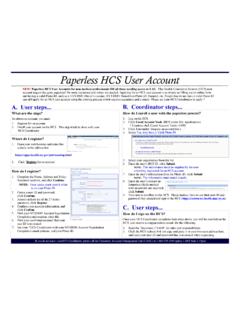Transcription of Institutional Special Needs Plans (“ISNPs”): Clinical
1 Institutional Special Needs Plans ( ISNPs ): Clinical and Financial Considerations AUDIO CONFERENCE. Date/Time: March 1, 2017, 10:30 11:30 Presenter: Marc Zimmet President Zimmet Healthcare Services Group, LLC, Morganville, NJ. Packet Contents: Handout Credit Instructions CEU Affidavit Evaluation/Credit Form Post-Test Dial-In Instructions: Conference Phone Number: 1-888-585-9008. Participant Access Code: 770817558#. You may dial the toll-free number no sooner than five minutes prior to the program. LeadingAge New York/FLTC 13 British American Blvd. Suite 2 Latham, NY 12110 Institutional Special Needs Plans (ISNPs): Clinical and Financial Considerations for Skilled Nursing Facilities Agenda Introduction Understanding the Money Flow Clinical Considerations Financial Considerations IPA Contracting Arrangements Medicare ECCP (ISNP competition?)
2 Additional Resources Disclaimer This webinar is designed to provide an overview of the Institutional Special Needs plan program and market trends in different states. Some of the concepts presented within are simplified, estimated or generalized for discussion purposes; participants may contact presenter for amplification or clarification. Presenter is a Member in Alpha Healthcare IPA, LLC, an entity that manages ISNP programs on behalf of Medicare Advantage Plans . Introduction Improving Quality and Efficiency (utilization & cost reduction) are common themes in the Healthcare Reform / Alternate Payment Model movement Managed Care, ACOs, Bundles, Episodic, CCJR, etc. Medicare Advantage penetration is nearly one-third of all beneficiaries (and half of new beneficiaries).
3 Over 8% annual enrollment growth Medicaid systems transitioning to LTC managed care LTC residents are Medicare's last FFS cohort ISNPs target only this population Special Needs Plans SNPs are optional Medicare Adv. programs designed to improve quality & reduce costs for specific populations Institutional SNP (ISNP) applies to long-term care / SNFs Authorized By Medicare Modernization Act (MMA) of 2003 (would not be impacted by ACA repeal). ISNPs enroll only Medicare (A & B) eligible LTC residents (regardless of primary payer, no impact on CMI). Goal is to improve outcomes and reduce costs (esp. hospital admissions) through improved coordination of care management and enhanced Clinical protocols Use of Nurse Practitioners and emerging care management resources ( TeleHealth, Technology).
4 Types of MA SNPs Enrollment limited to beneficiaries with specialized care Needs Wide array of Plans , varying degrees of success Most recent data and policy suggests ongoing commitment to dual-eligible and Institutional SNP models Benefits of ISNP Participation 1. Enhance Clinical capabilities 2. Move up the managed care value chain 3. Prepare for new FFS and managed payment models (bundle, episodic, capitation). 4. Leverage market position and Clinical excellence to counter downward rate pressure 5. Introduce tools relating to risk tolerance . and assumption of risk 6. Share in program savings 2016 ISNP Enrollment Total 55,439 Source: Kaiser Family Foundation New York 16,474 Indiana 753 Florida 3,840 Oregon 748 Pennsylvania 3,383 Delaware 520 Connecticut 2,912 Nevada 514 Maryland 2,870 Missouri 314 Colorado 2,772 New Mexico 301 Georgia 2,541 Alabama 262 North Carolina 2,457 Texas 229 California 2,451 Kansas 228 Arizona 2,192 Virginia 163 New Jersey 1,898 Oklahoma 156 Wisconsin 1,828 Massachusetts 132 Washington 1,652 DC 80 Rhode Island 1,599 Kentucky 79 Ohio 1,131 Michigan 16 Illinois 944 Remaining 20 - Active NY SNPs (2015).
5 plan Geographic plan Contract Name Name Enrollment UNITEDHEALTHCARE OF New York 9,052. NEW YORK, INC. Metropolitan area UNITEDHEALTHCARE OF. Upstate New York 3,837. NEW YORK, INC. NYC, Westchester, CATHOLIC Special Needs . Putnam, Dutchess, 1,699. plan , LLC. Orange, Ononda INDEPENDENT HEALTH. Western New York 1,365. ASSOCIATION, INC. NYC, LI, CENTERLIGHT. Westchester and 1,082. HEALTHCARE, INC. Rockland Counties Brx, Ki, Monr, Na, ELDERPLAN, INC. NY, Qu, Ri, Suf, 835. Wes Active NY SNPs (2015). plan Geographic plan Contract Name Name Enrollment HEALTHFIRST HEALTH NYC and Nassau 418. plan , INC. County NYC Metro Area, LI, AGEWELL NEW YORK, LLC 50. Westchester NYC Metro, CENTERS plan FOR. Rockland, Erie, 20. HEALTHY LIVING, LLC. Niagara Counties: Brx, Ki, ELDERSERVE HEALTH, INC.
6 Na, NY, Qu, Ri, - Wes Bronx, Kings, New ALPHACARE OF NY, INC. York and Queens - Counties. * Enrollment figures include contracts through IPA arrangement The Most Common Questions How does contracting work? Do all my long-term care patients have to enroll? How does enrollment work? Do we still bill Medicare for enrolled patients? Do only Medicaid primary patients qualify? Does ISNP enrollment impact Medicaid CMI? How does my Medicare short-term re-hospitalization rate impact my performance? How does ISNP enrollment impact my therapy billing and relationship to my contract therapy company? Can I have more than one ISNP plan in my facility? What if we can't effectively manage clinically? The Money Flow CMS pays the plan PMPM Premium for each enrolled beneficiary For purposes of this webinar, we will use $2,000 per member per month premium as an example plan has overhead, ACA sets minimum spending % ( Medical Loss Ratio or MLR ).
7 Enrolled residents are no longer Fee-for-Service . PMPM Premium is based on the base rate per County adjusted by Hierarchical Condition Code ( HCC ) scoring per patient Goal is to optimize HCC scoring for highest PMPM. Recent CMS accusations of over coding by Plans 2017 base is reduced (causing plan exit in some Counties). May be mitigated in part by improved HCC accuracy SNF may contract directly with the plan or through an IPA. If IPA used, payment may still flow directly to SNF. Clinical Considerations How well do I manage Clinical changes of my long-term care population? How does my hospitalization rate and Medicare billing (for LTC population) compare to my peer group of providers (internal and third party)? Am I prepared to Care in Place . Am I prepared to do so at all hours.
8 Is my nursing staff up to the challenge? Clinical Considerations What additional resources will I need to reduce hospitalizations of my LTC population? Am I prepared to integrate third party Clinical judgement into my care model? How do I reconcile family demands and expectations? What will my physicians think of this program? Financial Considerations How much Medicare revenue am I generating from my FFS long-term care population? How it works: All Medicare payments, administration costs, NP, etc. must be paid by the plan from PMPM Premium Evaluate LTC hospital admits ( Admits/1,000 ). Part A revenue derived from LTC population What is my average Part A rate for LTC population? Part B therapy (billing, therapy company use, cap issues) & other ancillaries (are they related parties?)
9 Medicaid rate: Higher rate makes SNP more attractive because Medicaid days will increase as Part A decreases Contemporary ISNP Payment Model Fixed PMPM to SNF for Medicare Part A replacement . revenue Fixed PMPM to SNF for Medicare Part B replacement . revenue (mostly therapy). Small allowances for additional Part B items ( Blood Glucose testing). Small PMPM for certain quality issues ( immunizations, Survey, etc.). Shared Savings component: Calculated as a percentage of remaining Premium after all costs are deducted, including plan administration May include only Upside or both Upside and Downside risk Typically reconciled and paid 2 4 times per year The ISNP Equation Poor Excellent Marginal Candidates Candidates Many LTC Few LTC. hospitalizations hospitalizations High % of Part A $ Low % of Part A $.
10 From LTC population from LTC. High Part B Low ancillaries/. ancillaries (esp. in- outsourced therapy house therapy). Higher MA rate Low MA rate SNP EXAMPLE Calculation (all #s per month). CMS pays plan : $2,000 PMPM. plan pays SNF: $380 PMPM (Part A guaranty). plan pays SNF: $50 PMPM (Part B guaranty). plan pays SNF: $20 PMPM (Other incentives). plan pays other: $850 average PMPM. plan admin: $100 PMPM. Remaining: $600 PMPM. SNF share (30%): $180 PMPM. PMPM SNF revenue: $630 PMPM. Enrollees per month x 100. TOTAL SNF rev/mo: $63,000. Compare this to current FFS. SNP EXAMPLE Comparative Calculation Comparing historical Financial net revenue pre/post- SNP (for SNP population): Part A revenue from LTC population (1): $100,000. Less: Ancillary costs during stay (2): $ 10,000.

![Writing Your QAPI Plan [Read-Only] - LeadingAge …](/cache/preview/b/9/9/8/2/3/f/a/thumb-b99823fa2ae9636b8ed3230c56f78051.jpg)


![Writing A Plan of Correction LW [Read-Only]](/cache/preview/6/5/3/2/3/f/e/3/thumb-65323fe36af0a4e891a910cd28e7a239.jpg)





